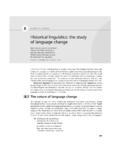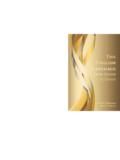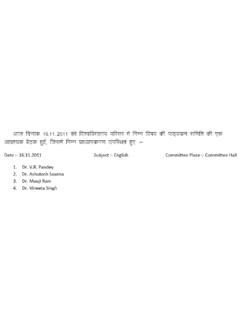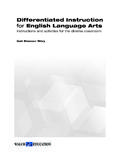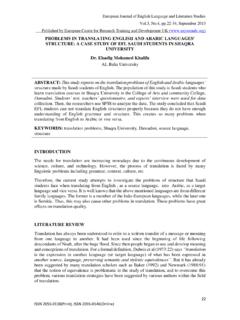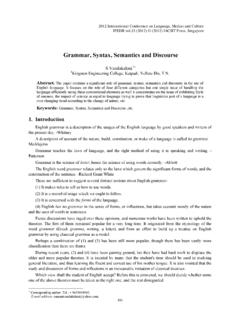Transcription of A grammar of contemporary English. London: …
1 Review: [untitled]. Author(s): D. Terence Langendoen Reviewed work(s): a grammar of contemporary english by Randolph Quirk ; Sidney Greenbaum ; Geoffrey Leech ; Jan Svartvik Source: Journal of Linguistics, Vol. 11, No. 2 (Sep., 1975), pp. 277-280. Published by: Cambridge University Press Stable URL: Accessed: 12/05/2009 09:17. Your use of the JSTOR archive indicates your acceptance of JSTOR's Terms and Conditions of Use, available at JSTOR's Terms and Conditions of Use provides, in part, that unless you have obtained prior permission, you may not download an entire issue of a journal or multiple copies of articles, and you may use content in the JSTOR archive only for your personal, non-commercial use.
2 Please contact the publisher regarding any further use of this work. Publisher contact information may be obtained at Each copy of any part of a JSTOR transmission must contain the same copyright notice that appears on the screen or printed page of such transmission. JSTOR is a not-for-profit organization founded in 1995 to build trusted digital archives for scholarship. We work with the scholarly community to preserve their work and the materials they rely upon, and to build a common research platform that promotes the discovery and use of these resources. For more information about JSTOR, please contact Cambridge University Press is collaborating with JSTOR to digitize, preserve and extend access to Journal of Linguistics.
3 REVIEWS. seriously affect my view of it as an excellent introductorywork, lucid, amusing and the second edition Matthewswill no doubt remodel the last chapter and so eliminatemost of the book's even in its present state it will rescue freshmen linguists who have too often been (in Milton's words) 'tossed and turmoiledwith their unballastedwits in fathomlessand un- quiet deeps of controversy'. REFERENCES. Agard, F. B. & Di Pietro, R. J. (I965). The grammatical structures of english and Italian. Chicago: Chicago University Press. Chomsky, N. (1965). Aspects of the theory of syntax.
4 Cambridge, Mass.: MIT Press. Kiefer, F. (1970). Morphological processes in generative grammar . ALH 20. I5-57. Kiefer, F. (I973). Generative Morphologie des Neufranzisischen. (Romanistische Arbeit- shefte 2) Tiibingen: Niemeyer. Matthews, P. H. (I967). Review of Chomsky, I965. JL 3. 119-I52. Matthews, P. H. (I972). Inflectional morphology. A theoretical study based on aspects of Latin verb conjugation. (Cambridge Studies in Linguistics: 6) Cambridge: Cambridge University Press. Wurzel, W. U. (1970). Studien zur deutschen Lautstruktur. (Studia Grammatica 8). Berlin: Akademie Verlag.
5 Reviewed by REBECCAPOSNER, (Received 7 January I975) University of York. Randolph Quirk, Sidney Greenbaum, GeofErey Leech & Jan Svartvik, A grammar of contemporary :Longman,1972. Pp. Xii+ I,I20. The dust jacket proclaimsthat 'A grammarof contemporary Englishis the fullest and most comprehensive synchronic description of english ever written'. If 'synchronic'is construedso as to rule out Jespersen'sModernEnglishgrammaron historicalprinciples,then one can hardlyquarrelwith the the first chapter, an introductory essay on 'The english language' is excluded, the grammarincludes I3 chapters and 3 appendices, divided into I,204 sections covering almost exactly i,ooo pages (discountingthe pages devoted to the table of contents for each chapter and appendix).
6 Ch. 2 presents an outline of the structureof english sentences in such a way as to motivate the organizationof the rest of the book. It is followed by chaptersdealing with the verb phrase(the verb and its auxiliaries),the basic noun phrase, adjectives and adverbs, and prepositionsand preposition phrases. Ch. 7 provides a detailed examinationof simple sentences;this is followedby chapterson adverbialphrases,co-ordination and apposition,sentenceconnexion,complex sentences,predicatestructures,and complex noun phrases. Ch. I4 is called 'Focus, theme, and emphasis',and deals with variationsin sentencestructureas they relateto the presentationof informa- tion.
7 The three appendicesdeal with word formation,prosody,and punctuation. 277. JOURNAL OF LINGUISTICS. Thus, the book has a kind of cyclical organization,with the structure (and, ultimately,function) of sentences as the recurringtheme. It is an excellentlylaid out book, fine for both browsingand for examiningspecific topics. The 28-page index and the I7 tables of contents makelookingthings up almostpleasurable. The book espouses no particular theory, for which the authors provide justification by remarking,'None, however, seems yet adequateto account for all linguistic phenomena'(vi), and no detailed discussion of theoreticalissues is provided.
8 The authors, however, acknowledgetheir indebtedness both to the scholarlytraditionof grammarwriting, and to the insights of severalcontempor- ary schools of linguistic theory, notably those of the transformational-generati- vists. The book is a lot more like a contemporarylinguistic work than like the compendiousgrammarsof the past, by virtue of its having adoptedmany of the styles and techniques of current linguistics, such as the use of numbered examples(almostentirelymade up ratherthan cited from literature),criticaluse of ungrammaticalsentences, the pointing out of linguistic generalizations,and the presentationof detailed arguments in defence of many of their structural claims (a typical example occurs on p.)
9 64, in which the authorsgive a systematic argument showing why sentences like He expectednot to see the play are not counterexamplesto their claim that when a verb is negated, do is introduced). Moreover, despite the authors' disclaimers, the book is far from devoid of linguistic theorizing. They speak freely of 'transformationalrelations' among sentences, by which they appearto have in mind the kind of relationsin Harris'. theory of , in deciding whether sentences are to be related transformationally,they sometimes apply criteriathat are irrelevantto Harris' notion.
10 Thus they argue that a sentence like He's eating is not to be transformationallyrelated to any transitive sentence like He's eating something, but ratherthat the formercontainsa verb morphologicallyderivedfrom the verb of the latter. The reasonthey give is that the process,if transformational,should apply generallyto transitiveverbs, which it does not. However, if this criterion is applied systematically,it would also rule out relations such as that between She sent him a bookand She sent a bookto him, which the authors do consider , then, is the extent of the theorizingto be found in this book: up to the point at which results are obtained that confirm the authors'.


